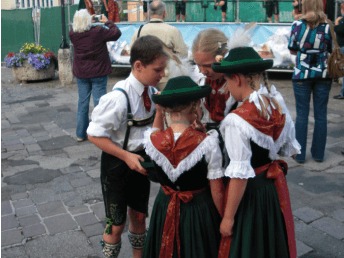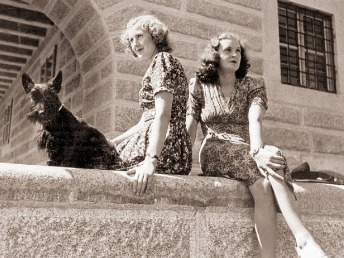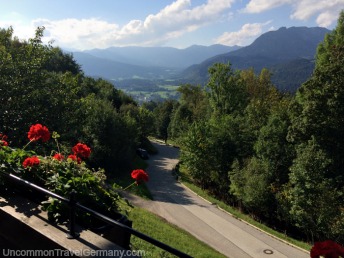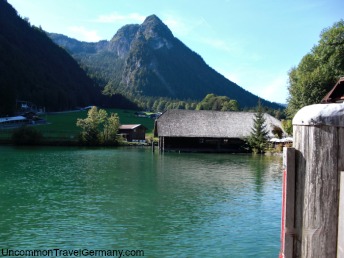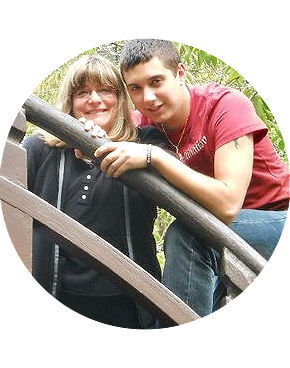- Home
- Hitler's Berghof
- Braunau am Inn
Braunau am Inn - Austria
Braunau am Inn, Austria, is a pretty town of about 17,000 people, right on the German border, and well worth a visit.
It's known internationally as being the birthplace of Adolf Hitler, but there's also lots more to its history, and it's an interesting place to explore.
History of Braunau am Inn
The earliest written mention of Braunau am Inn was in 1120.
During the Middle Ages, Braunau was an important and prosperous town, largely due to its location on a trade route and its position on the navigable River Inn. It was a fortified town and often had soldiers garrisoned in it.
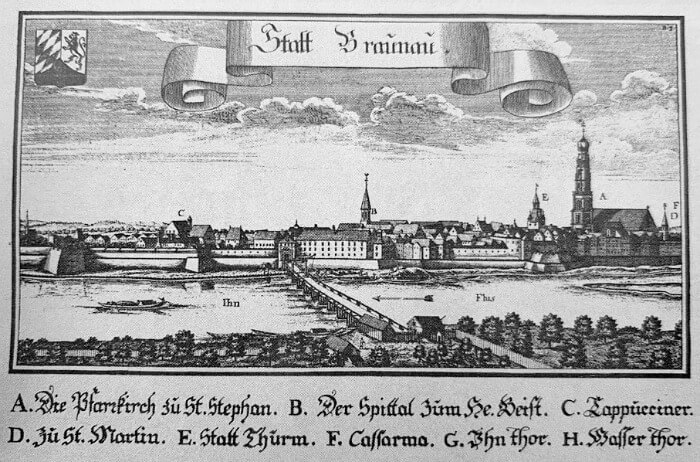 Braunau am Inn
Braunau am InnAustrian or Bavarian?
Braunau am Inn now lies in Austria, just across the border from Germany. But the town has been part of Bavaria for most of its history.
Austria acquired Braunau in 1779 as a result of the War of the Bavarian Succession, and the town changed hands several times during the European wars that followed.
Napoleon's army controlled the town in the early 1800's and Napoleon himself made two visits to Braunau am Inn, in 1805 and 1809.
The town was in Bavarian hands again in 1816, but was traded for Ascheffenburg, and has remained Austrian since then (except for the years 1938 to 1945, when it was part of the Third Reich).
Border Town of the Austro-Hungarian Empire
The River Inn was the border between Austrian Empire and the Kingdom of Bavaria, and later, between Austria and Germany.
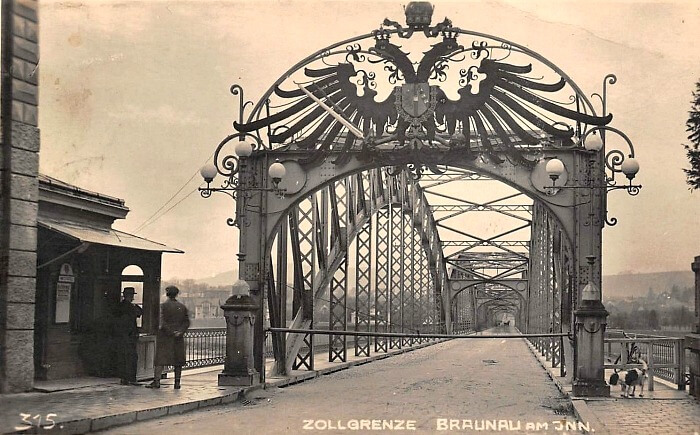 Border checkpoint at the bridge in 1910
Border checkpoint at the bridge in 1910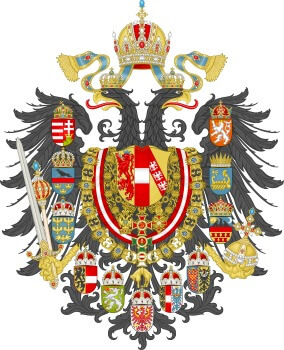 Austria's Coat of Arms
Austria's Coat of ArmsThe checkpoint at the bridge above was on the Austrian side of the river, at the edge of the town of Braunau am Inn.
You can see the imperial coat of arms on the bridge.
The German town of Simbach am Inn lay on the other side (still does).
The Third Reich in Braunau am Inn
The steel bridge in the photo above was still there when Hitler annexed Austria in 1938. Shortly after the Anschluss, Hitler paid a visit to the town of his birth (his only visit).
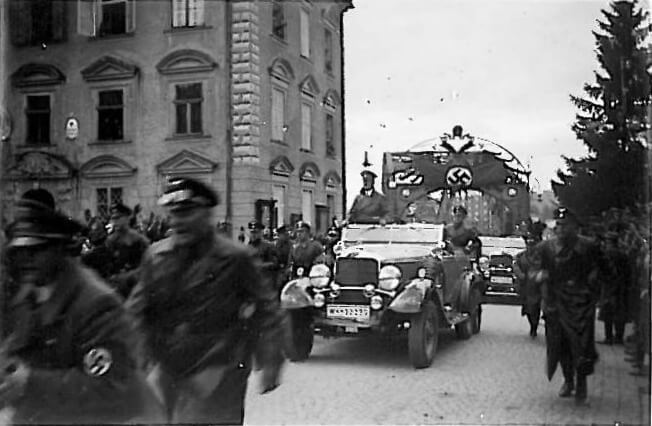 Hitler arriving in Braunau after the Anschluss 1938
Hitler arriving in Braunau after the Anschluss 1938The building on the left is still there, but the steel bridge was blown up by the German army on May 1, 1945, as the American army was advancing towards it.
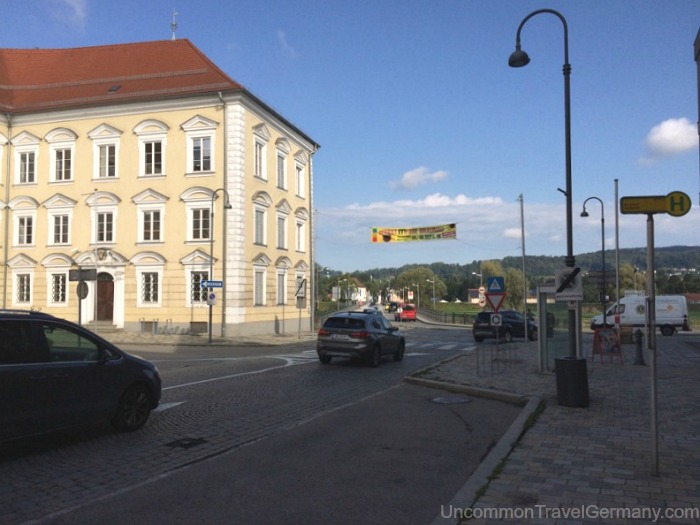 Current approach to the bridge
Current approach to the bridgeThe U.S. army engineers built a pontoon bridge to cross over into Braunau.
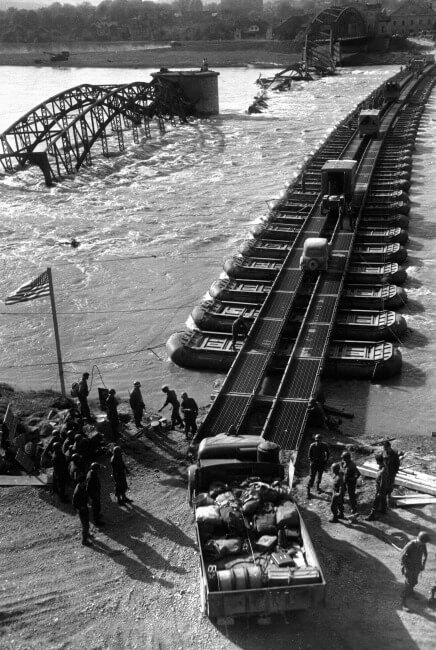 Pontoon bridge, May 1945
Pontoon bridge, May 1945The war almost didn't end this way for Braunau am Inn. The local Gauleiter had forbidden the surrender of this important town.
On May 1, 1945, an entire division of the American army was waiting across the river, expecting a major battle. They fired a couple of shots at the church tower and gave the town a deadline of noon on May 2 for the surrender.
The commander of the German army in Braunau came to a decision just in time; the town surrendered three minutes before the deadline.
Current Border
The checkpoints are no longer there, now that the border between the two countries is open.
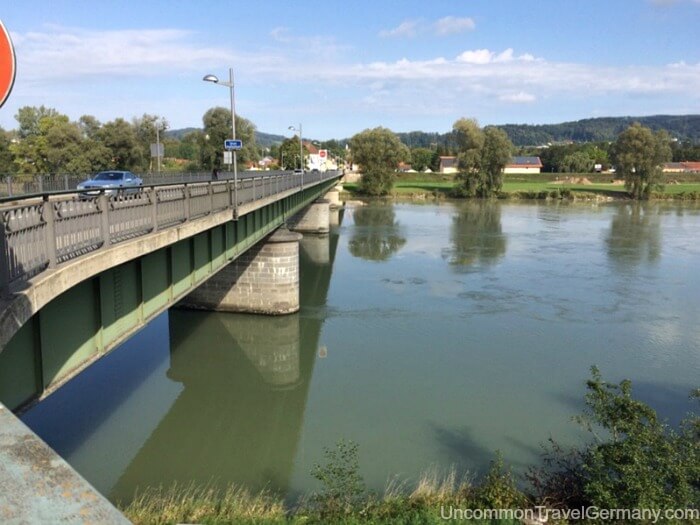 Current bridge, looking towards Germany
Current bridge, looking towards GermanyBorder controls were reinstated briefly on the German side in 2015 as a result of the massive influx of migrants arriving in response to Chancellor Merkel's invitation.
What to see in Braunau am Inn, Austria
The Stadtplatz. The main plaza in Braunau runs for several blocks, starting right at the entrance to the town, coming in from the bridge.
The pretty pastel buildings line the Stadtplatz with lots of shops and restaurants to explore. In good weather, there are a number of pleasant places to sit outside and admire the view over some schnitzel and a local brew.
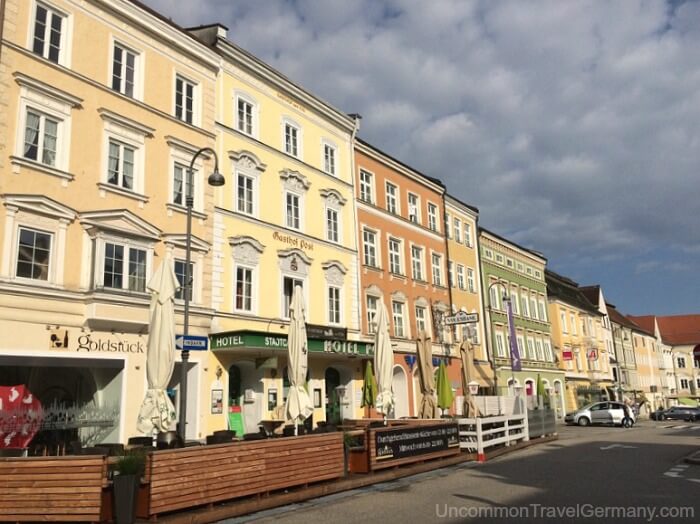 Braunau am Inn Stadtplatz
Braunau am Inn StadtplatzIt's an attractive town; it's fun to wander the streets, checking out the older part of the city.
Some of the buildings date back to the Middle Ages, like the Torturm (Gate Tower) and St. Stephan's Church, and others display the styles of intervening centuries.
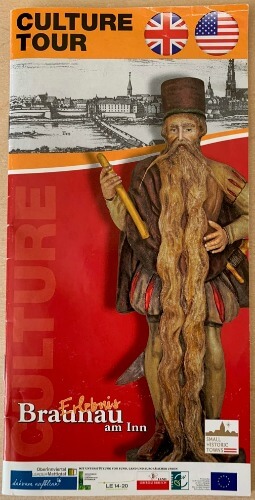
Tip: I recommend stopping by the Tourist Information Office at Stadtplatz 2 and picking up their booklet on Braunau am Inn. It has an excellent description of interesting things to see in Braunau and where to find them.
Plus a town map with the sights marked on it. Perfect for a do-it-yourself-tour. I found a lot of good information in it.
Note: I may earn a small commission if you make a purchase through some of the links on this page, at no extra cost to you. This helps me provide all the free information I post on this website. Thank you for your support!
The Town Hall
The Town Hall, or Rathaus, is an interesting building, and looks older than it is. It's on the Stadplatz.
It was built in 1905 and sports a statue of Braunau am Inn's other famous citizen, Hans Steininger...immediately recognizable from his astoundingly long beard! He turns up all over Braunau.
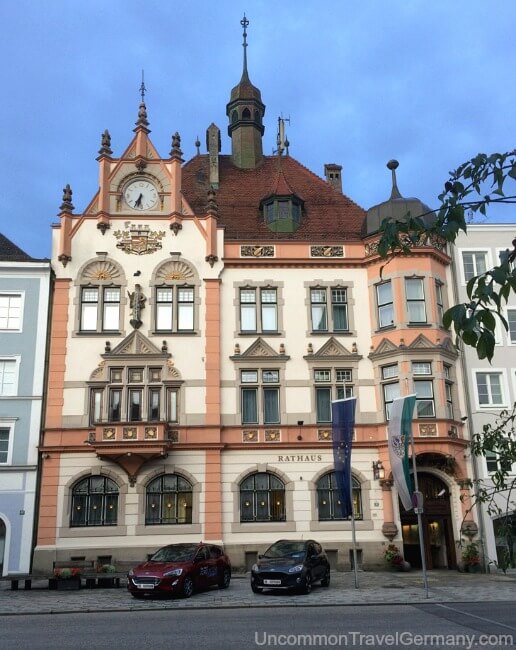 Braunau am Inn's Rathaus
Braunau am Inn's RathausThe longest beard...
Hans Steininger was captain of Braunau's army in the 16th century. His beard was over 6 feet long and he normally kept it rolled up in a pouch or wrapped around his foot (hard to picture, but that's what they say).
One night in 1567, there was a fire in the town, and as he rushed out to help, he tripped on his beard and broke his neck.
There are carvings of him, and his beard, on the side of St. Stephan's Church, and the beard itself is in the Regional Museum!
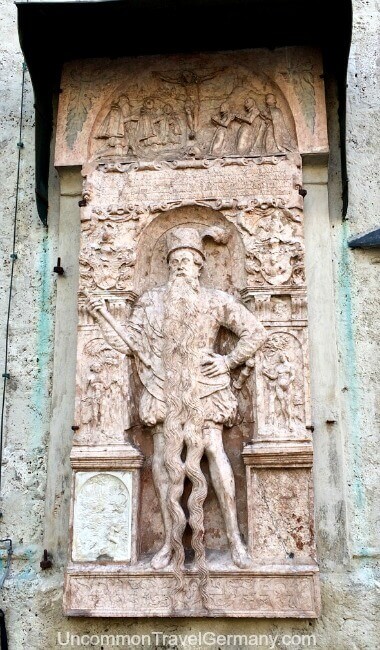 Hans Steininger, St. Stephan's Church
Hans Steininger, St. Stephan's ChurchHitler's Birthplace
Adolf Hitler was born in Braunau am Inn on April 20, 1889.
His father, Alois Hitler, was a customs agent working for the Austrian government and was posted to Braunau in 1875. In 1885, he married Klara Plötzl and together they had six children.
Alois had two children from a previous marriage living with him when he married Klara. Their first four children were born while they lived in the top flat of what was the Pommer Inn, at Salzburger Vorstadt 15.
Their first three children died there as infants, two from diphtheria during one winter. The fourth child was Adolf.
His two younger siblings were born after the family moved from Braunau. His younger brother Edmund was born in Passau and died at the age of six from the measles; his younger sister Paula was also born in Passau.
Adolf and Paula were the only children of Alois and Klara who lived to adulthood. Paula died in 1960 and is buried in Berchtesgaden.
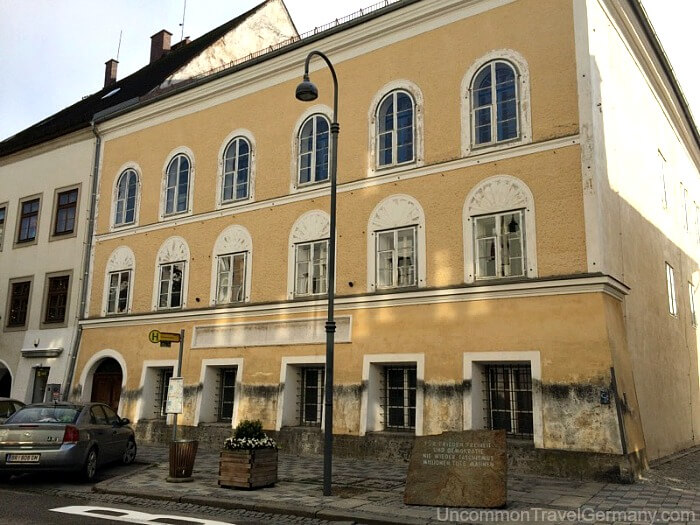 Hitler's Birthplace, Salzburger Vorstadt 15
Hitler's Birthplace, Salzburger Vorstadt 15The building was a gasthaus at the time, with a restaurant on the ground floor and rented flats and rooms above.
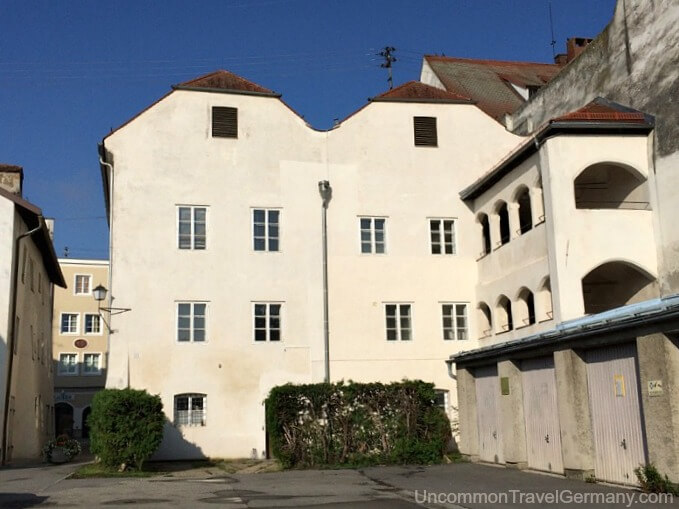 Rear of Hitler's Birthplace.
Rear of Hitler's Birthplace.The Hitler family lived there until 1892, when the father Alois was transferred to nearby Passau, in Germany; Adolf was three years old when they left Braunau am Inn.
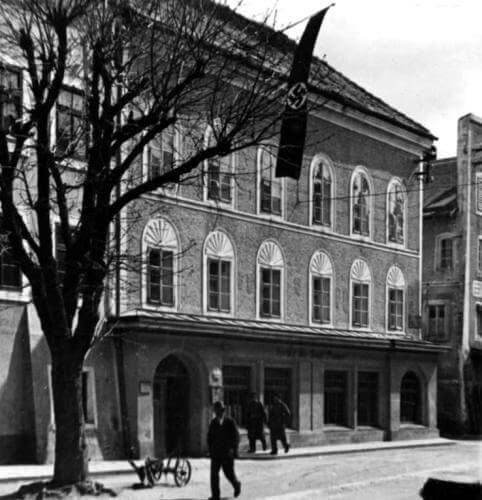 Hitler's Birthplace during the Third Reich
Hitler's Birthplace during the Third ReichIn 1938, Martin Bormann bought the building from the Pommer family (who had purchased it in 1913), and the building was restored to the family in 1952.
Close call in 1945. The building was almost destroyed during the final days of World War II.
On May 2, 1945, one day after the town had surrendered and the Americans had taken possession, a German force, on orders from the local Gauleiter, attempted to enter Braunau am Inn to blow up the building, to prevent it from falling into enemy hands.
The German force was stopped at the roundabout at the entrance to Braunau, near the river.
Current Status of Hitler's Birthplace
The legal wrangling over the fate of this building has been going on for years, but it appears that a final decision has been made.
It is scheduled to be remodeled and turned into a police station, starting in late 2023 and likely finished in 2026.
Some history...
The building was still owned by members of the Pommer family until 2016.
The Austrian government had been leasing it from the owners since 1972 and it had been used for a number of different purposes since then.
It's been empty since 2011, and is not open for visitors.
There has been strong political pressure to demolish the building. In 2016, the Austrian government expropriated the property and was planning to tear it down and build something else there, or change the outside as to make it look totally different.
Since then, opposition has arisen to the destruction of an historically significant building.
In February, 2019, a court order directed the Austrian government to reimburse the previous owner, Frau Gerlinde Pommer, in the amount of 1.5 million Euros (about $1.7 million).
She had previously been awarded 310,000 Euros (about $350,000) in 2016, which she felt was an inaccurate valuation of the property. The final settlement was for 810,000 Euros (about $900,000).
The latest developments involving the building.
On November 20, 2019, the Austrian government announced that Hitler's birth house will be remodeled and used to house the Braunau police department.
A competition was held to choose the new design for the building, and in 2020, the winner was announced: Marte.Marte Architects, an Austrian firm.
How much will Hitler's birthplace be changed? From their announcement, and taking a look at the proposed mockups, it appears the exterior will be somewhat redesigned, but that the building will be "architecturally integrated" into the existing buildings of that area, as they put it. And the interior will be quite different.
The surrounding buildings look about the same age and style as the Hitler family's home, so does that mean the remodeled building will retain the period style to fit in? Sort of, it seems.
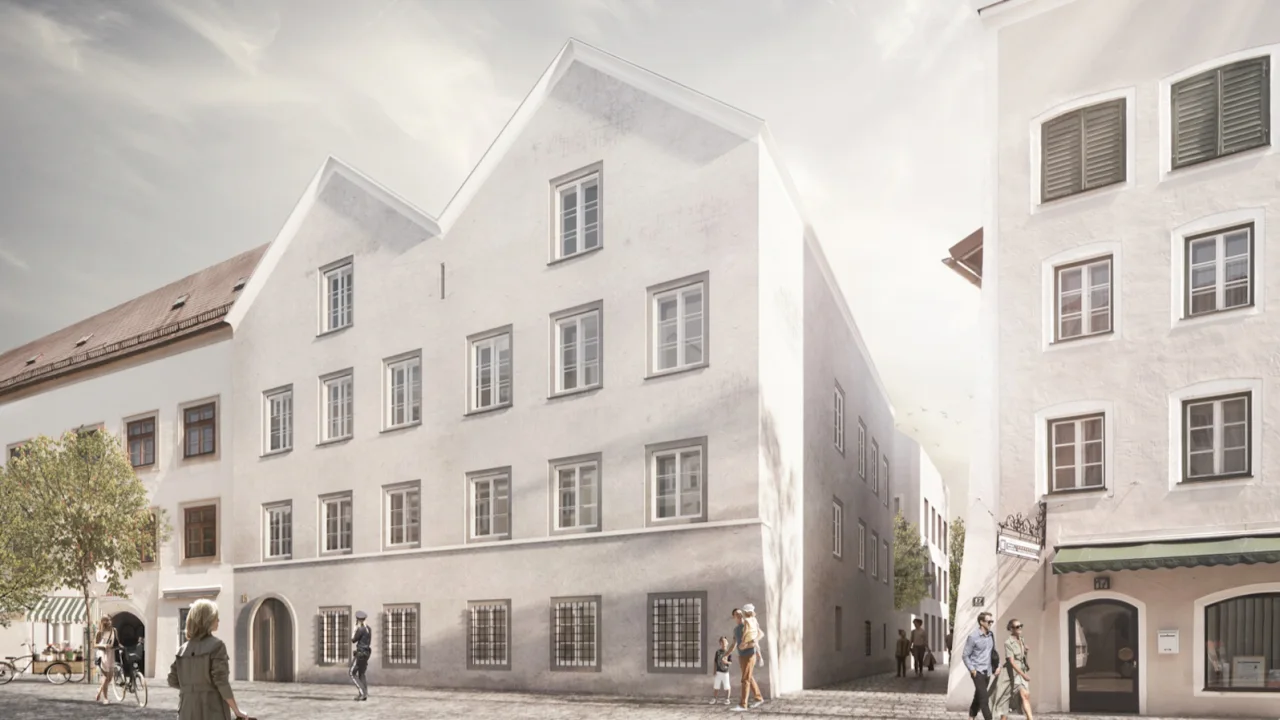 Winning design for the remodel
Winning design for the remodel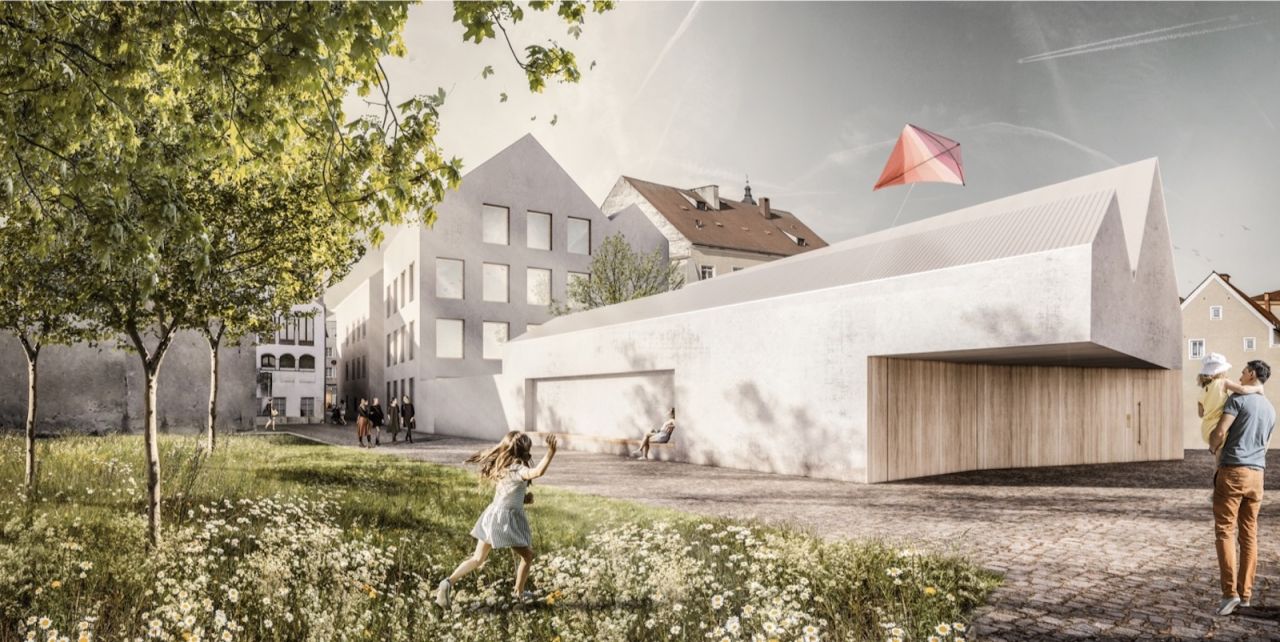 Rear view of proposed remodel
Rear view of proposed remodelWork on the remodel is expected to start in the fall of 2023, with an opening date planned for 2026.
The current plan, announced by the Austrian government, is that the building will be used as a police station and will incorporate a center to train police in human rights. See Guardian article on it.
If you want to see the building in its original form, go now.
St. Stephan's Church
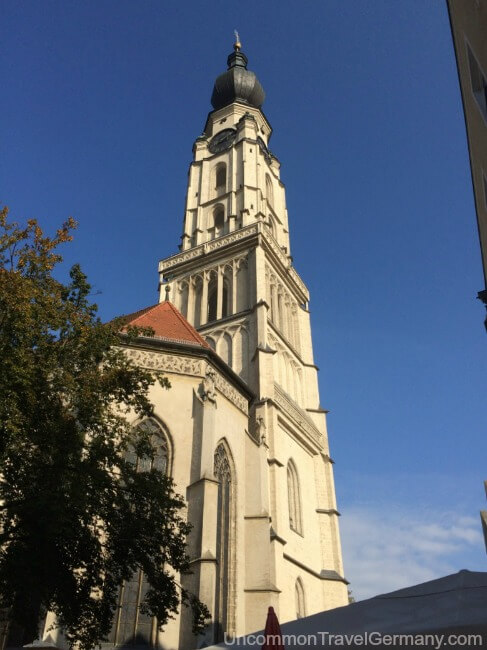 St. Stephan's Church
St. Stephan's ChurchThis beautiful and very large church was built between 1439 and 1466; it has one of the tallest church towers in Austria.
The wooden pews were custom-built to accommodate the sizes and figures of some of the local parishioners, so they vary. Fun to check them out!
It's likely that the Hitler children were baptized in this church, including Adolf. The baptismal font is very old and you can see it inside.
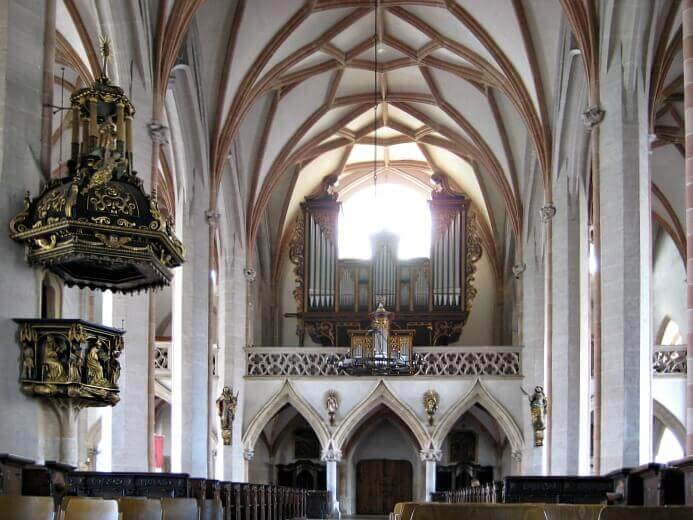 St. Stephan's Church interior
St. Stephan's Church interiorMore things to see...
Wandering around, you'll see some of the old towers and walls left from Braunau am Inn's days as a fortress.
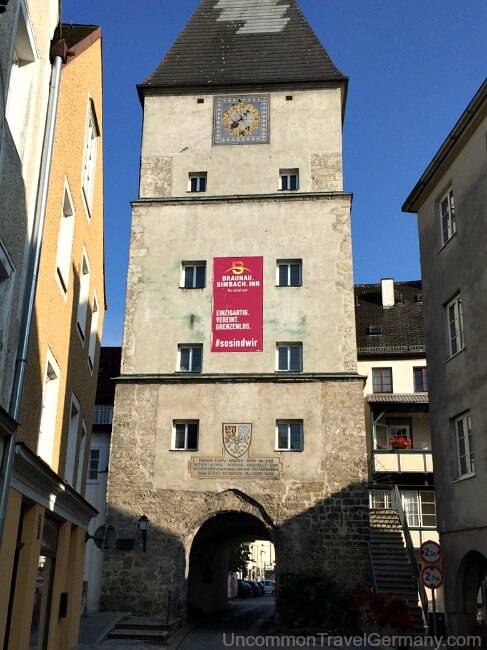 The Torturm (Gate Tower)
The Torturm (Gate Tower)The tower's bells are rung at 8 am, noon and 6 pm every day; the evening bells play Brahms' "Lullaby".
Plague warning. There's a skull sculpted in the city wall on the west side of the old city, allegedly was placed there to warn travelers about the plague if they were heading down river.
To find it, you have to walk along the path that runs below the wall, almost to the end before the path turns away from the wall. It's just below the top of the wall.
The Iron Horse
There's another sculpture of interest on top of a building on Linzerstrasse, about two blocks from the Stadtplatz.
You'll see a metal horse on top the the roof of a blue building. The horse was allegedly put there as a reminder of a siege in Braunau. After they ate the last horse, they surrendered and opened the gates.
You can see that the horse has some holes in it. When the Americans occupied the town in May of 1945, some of the soldiers took shots at the horse.
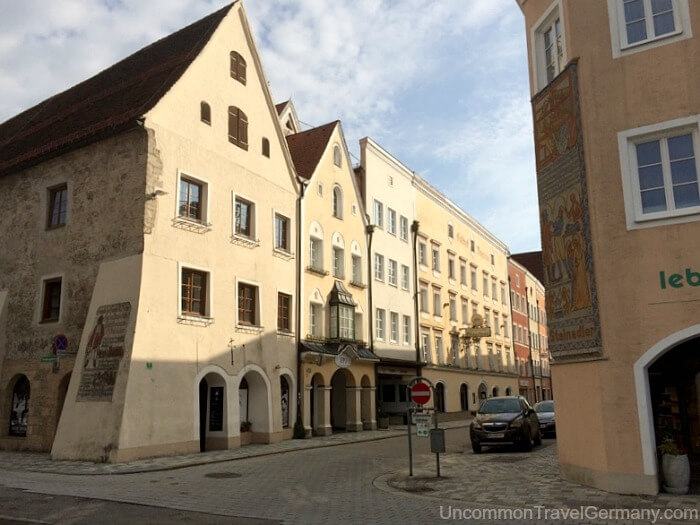 Linzer Strasse - Iron Horse & Hotel Mayrbräu
Linzer Strasse - Iron Horse & Hotel MayrbräuNapoleon slept here...
Napoleon did spend two nights in Braunau am Inn, in 1805 and 1809. The inn he stayed at is now called the Schüdl-Haus.
Legend says he sat on a bench in front and spoked a pipe; the bench in question is on display in the Heimathaus, the local museum on Johann Fischer-Gasse, off the Stadplatz.
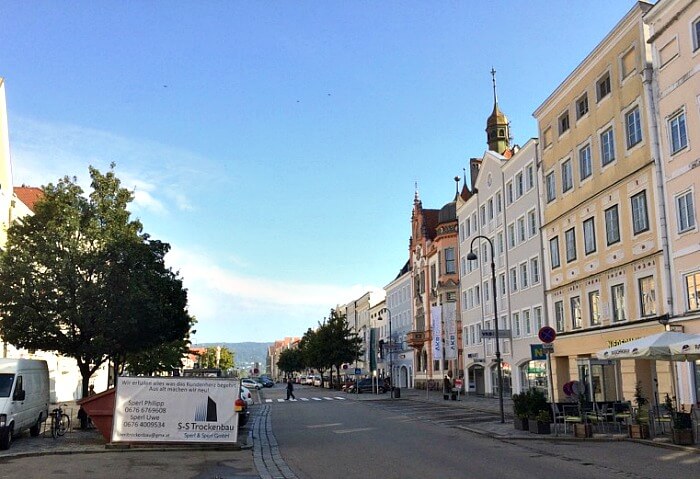 Stadtplatz. The yellow building on the right is the Schüdl-Haus
Stadtplatz. The yellow building on the right is the Schüdl-Haus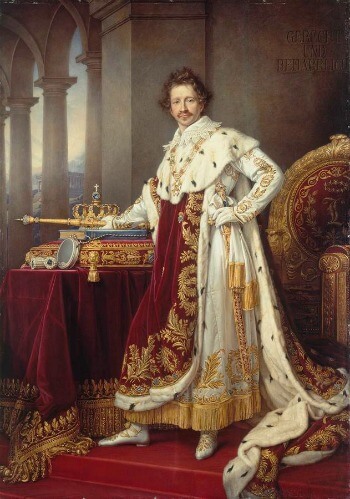 King Ludwig I of Bavaria
King Ludwig I of BavariaNapoleon wasn't the only illustrious guest at the Schüdl-Haus.
Two kings of Bavaria also stayed there: Ludwig I in 1813 and Maximillian I in 1805.
They were the grandfather and great-grandfather of the Swan King, Ludwig II, of Neuschwanstein fame.
Braunau am Inn Museums
Regional museum (Herzogsburg). This museum has exhibits about the history of the area, starting from the time of mammoths, through Celtic and Roman times, the Middle Ages, and beyond.
The incredible beard of Herr Steininger is on display there, also. Open Tue-Sat 1:30-5. Located at Altstadt 10.
Local museum (Heimathaus). This local museum has an intact bell foundry workshop dating back to 1385, plus the bench that Napoleon (supposedly) sat on. Johann Fischer Gasse 18.
One entry ticket covers both museums.
The execution of Johann Palm
A local bookseller named Johann Palm was executed in Braunau am Inn in 1806 on Napoleon's orders.
Palm had a bookshop in Nuremberg and had transferred a package to another bookseller which included a pamphlet critical of Napoleon, describing the sufferings of the German people under French occupation: Germany in Her Deep Humiliation.
He was accused of treason and was arrested by French troops in Nuremburg, brought to Braunau, and executed without a trial. He was considered one of the martyrs for German independence at the time.
A park was named for him in Braunau: Palmpark. There's a statue of him there, and the jail and cell where he was held in town is on Postallgasse.
Medieval Bath House
Few of these bath houses from the Middle Ages have survived, but the one in Braunau is in good condition and available for viewing.
Open Tue-Sat 10-5. Färbergasse 13.
Braunau am Inn mentioned...
The town of Braunau am Inn is mentioned in a couple of famous books: Tolstoy's War and Peace and Hitler's Mein Kampf.
War and Peace
Braunau turns up in Book 1 of War and Peace (the "war" in question being the Napoleonic Wars of the early 1800's).
"On October 11, 1805, one of the infantry regiments that had just reached Braunau had halted half a mile from the town, waiting to be inspected by the commander in chief. Despite the un-Russian appearance of the locality and surroundings- fruit gardens, stone fences, tiled roofs, and hills in the distance- and despite the fact that the inhabitants (who gazed with curiosity at the soldiers) were not Russians, the regiment had just the appearance of any Russian regiment preparing for an inspection anywhere in the heart of Russia."
Mein Kampf
Hitler talks about Braunau in the first paragraphs of Mein Kampf.
"TODAY it seems to me providential that Fate should have chosen Braunau on the Inn as my birthplace. For this little town lies on the boundary between two German states which we of the younger generation at least have made it our life work to reunite by every means at our disposal."
"...And so this little city on the border seems to me the symbol of a great mission. And in another respect as well, it looms as an admonition to the present day. More than a hundred years ago, this insignificant place had the distinction of being immortalized in the annals at least of German history, for it was the scene of a tragic catastrophe which gripped the entire German nation. At the time of our fatherland's deepest humiliation, Johannes Palm of Nuremberg, burgher, bookseller, uncompromising nationalist and French hater, died there for the Germany which he loved so passionately even in her misfortune. He had stubbornly refused to denounce his accomplices who were in fact his superiors. In thus he resembled Leo Schlageter. And like him, he was denounced to the French by a representative of his government An Augsburg police chief won this unenviable fame, thus furnishing an example for our modern German officials in Herr Severing's Reich."
Hotels in Braunau am Inn, Austria
When I was in Braunau, I stayed at the highly-rated Hotel Mayrbräu, which is a charming, older hotel right in the Altstadt.
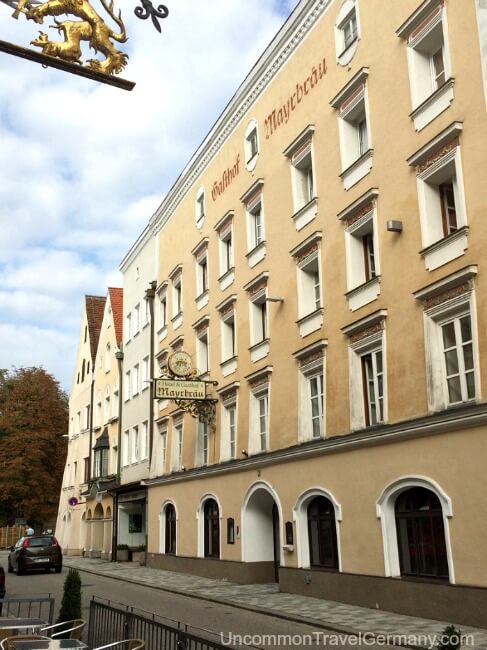 Mayrbräu Hotel
Mayrbräu HotelThe hotel is at Linzer Strasse 13, less than two blocks from the main Stadplatz, so it's quiet, but convenient. I was able to walk to all the places I wanted to see.
The traditional-style rooms were comfortable and clean, and the staff very pleasant. They had an unusual courtyard in the back for guests to relax in: faux-medieval castle, but with classical Greek statues here and there - different, but cool!
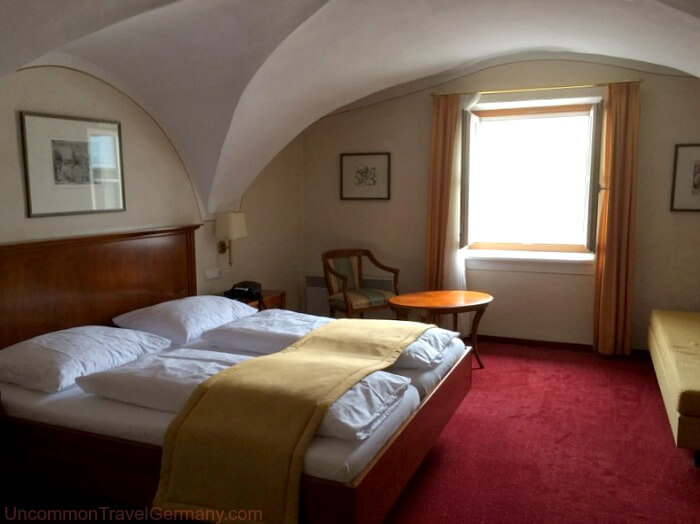 Our room at the Mayrbräu
Our room at the MayrbräuFor more info and booking, plus reviews, see Hotel Mayrbräu. From there, you can also take a look at the other the Braunau hotels.
Getting to Braunau am Inn
Braunau am Inn is on the Austrian-German border, just across the River Inn from Salmbach am Inn, Germany.
Braunau is about 2 to 3 hours by train from Munich, or a bit over 2 hours from Salzburg.
Berchtesgaden is about 2.5 to 3 hours from Braunau by train.
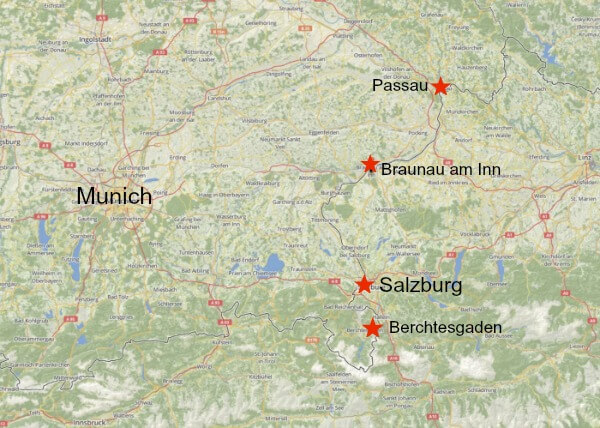
Travel tip. The train station in Braunau am Inn is about 1 km, or 0.6 miles from the town center, the Stadtplatz.
Not far, but not great dragging luggage. We walked it, but taking a taxi would have been a better choice!
Being a small town, they don't have a taxi stand at the station, but there are a number of taxi companies nearby which you can call.
Here are some taxis based in Braunau:
- citytaxi-braunau.at +43 7722 90918
- taxi-moser.at +43 7722 81711
- Innstadt taxi +43 7722 65165
- Central taxi +43 676 4260426
How do you actually call those numbers?
This is my understanding of how it works: 43 is the country code for Austria, and 7722 is the code for Braunau, and 676 means a mobile number in Austria.
If you have a US-based mobile phone, you dial +43 (or 011 43) then the rest of the number.
If you have a Europe-based mobile phone, but not an Austrian number, same procedure (but use 00 43 as an alternative for +43).
To dial a + on a mobile phone, hold down the 0 until a + appears. Dialing a + will enter the proper long distance code for you (011 or 00).
If you have a local SIM card for Austria, just dial the number, but put a 0 in front of the local code: dial 07722 or 0676; e.g. 07722 90918 for the first one on the list.
Map of Braunau am Inn, Austria
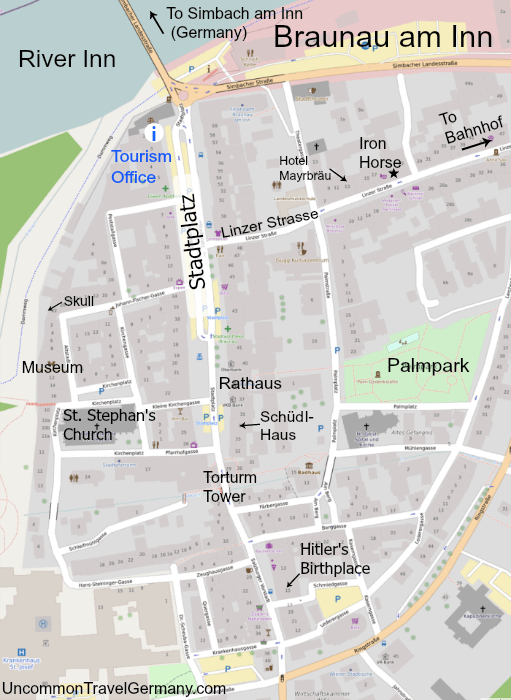
More to see in the area...
Silent Night, Holy Night. The well-known Christmas carol, Stille Nacht, Heilige Nacht, was first performed on Christmas Eve, 1818, in a village church not far from Braunau am Inn.
The original church in the town of Oberndorf was washed away in a flood in 1899, but there's a chapel there now, dedicated to the memory of the song.
Every year on Christmas Eve there's a 5 pm mass and the carol is sung. Viator has a tour there from Salzburg on Dec 24. See Silent Night tour for more info and booking.
The composer of the melody, Franz Xavier Gruber, was born in another village near Braunau (Hochburg-Ach).
And the author of the Silent Night lyrics, Joseph Mohr, was at one time a priest in the famous, much-photographed church in Ramsau, near Berchtesgaden.
The German Wild West. There's a real, Wild West town in Germany, not too far from Braunau, called Pullman City. They've created an amazing western theme park, with a western town, stagecoach rides and shootouts.
You can stay in one of the old western-style hotels and hang out in the saloon, or try out your line-dancing skills. It's sort of out of the way for travelers in Germany, but if you're already in Braunau, it's pretty close by.
It's near the town of Eging am See, outside of Passau, northwest of Braunau.
See Pullman City for more info.
Fun Fact. The fabled Orient Express went though Braunau am Inn. Running from Paris to Istanbul starting in 1883, the route was progressively shortened after 1977, and then finally discontinued in 2007.
The Austrian Empress Elizabeth (Sisi) came through Braunau on it.
Many thanks to the Tourism Office in Braunau am Inn for providing such a wealth of information about Braunau's history in their literature!
More to explore...
Share this page:
